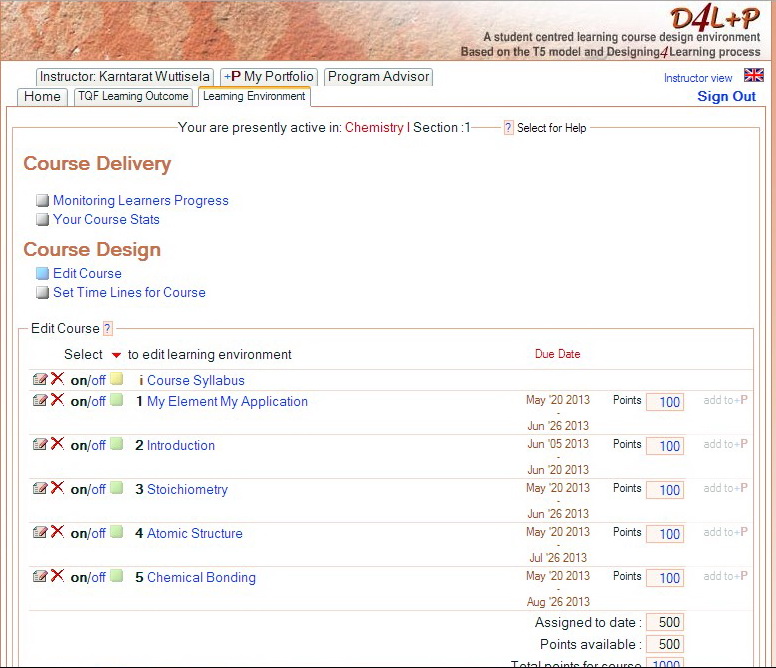ความพึงพอใจและความคิดเห็นต่อโปรแกรม Designing4Learning+Portfolio ของนักศึกษาที่มีเพศและความสามารถในการเรียนวิชาเคมีแตกต่างกัน
Main Article Content
Abstract
Karntarat Wuttisela
รับบทความ: 13 ตุลาคม 2556; ยอมรับตีพิมพ์: 8 ธันวาคม 2556
บทคัดย่อ
Designing4Learning+Portfolio (D4L+P) เป็นโปรแกรมที่ใช้เพื่อส่งเสริมให้นักศึกษามีปฏิสัมพันธ์กันมากขึ้นในการจัด-การเรียนรู้แบบบรรยาย โดยมีวัตถุประสงค์เพื่อศึกษาความพึงพอใจและความคิดเห็นต่อโปรแกรม D4L+P ของนักศึกษาแต่ละเพศและแต่ละระดับผลสัมฤทธิ์ทางการเรียน กลุ่มตัวอย่างคือนักศึกษาคณะเภสัชศาสตร์ชั้นปีที่ 1 จำนวน 99 คน นักศึกษาชาย 28 คนและนักศึกษาหญิง 71 คน นักศึกษาแต่ละคนถูกกำหนดให้ส่งงานที่ 1 2 และ 3 ของ 5 สภาพแวดล้อมการเรียนรู้ นักศึกษาส่งงานที่ 1 หลังการบรรยายแต่ละเนื้อหา สำหรับงานที่ 2 นักศึกษาแต่ละคนอ่านและให้ข้อเสนอแนะงานที่ 1 ของเพื่อนโดยประเมินจากความถูกต้องของงานที่ 1 ด้วยวิธีเดียวกัน ในงานที่ 3 นักศึกษาอ่านและให้ข้อเสนอแนะงานที่ 2 ในงานที่ 3 โดยประเมินจากความพยายามของเพื่อน แบบสอบถามเป็นเครื่องมือในการเก็บรวบรวมข้อมูลซึ่งแบ่งแบบสอบถามเป็น 6 กลุ่มได้แก่ นักศึกษาชายกลุ่มเก่ง กลุ่มปานกลาง และกลุ่มอ่อน นักศึกษาหญิงกลุ่มเก่ง กลุ่มปานกลาง และกลุ่มอ่อน ตามคะแนนรายวิชาเคมี 1 ของผู้ตอบแบบสอบถาม สถิติที่ใช้ในการวิเคราะห์ข้อมูลที่เก็บรวบรวมได้ ได้แก่ ค่าเฉลี่ย การทดสอบค่าเฉลี่ยด้วยค่าทีแบบกลุ่มอิสระ และการวิเคราะห์ความแปรปรวน ผลการวิจัยพบว่า นักศึกษาทั้งห้องมีความพึงพอใจต่อโปรแกรม D4L+P โดยภาพรวมและรายข้ออยู่ในระดับปานกลาง นักศึกษาชายและนักศึกษาหญิงมีความพึงพอใจไม่แตกต่างกันที่ระดับนัยสำคัญ .05 เช่นเดียวกับนักศึกษาที่มีผลสัมฤทธิ์ทางการเรียนแตกต่างกัน อย่างไรก็ตามนักศึกษาเพศหญิงมีความพึงพอใจต่อโปรแกรม D4L+P มากกว่าเพศชาย นัก-ศึกษาชายกลุ่มอ่อนมีความพึงพอใจมากที่สุดเพราะโปรแกรม D4L+P สะดวกต่อการส่งการบ้าน ส่วนนักศึกษาชายกลุ่มปานกลางมีความพึงพอใจน้อยที่สุด เพราะโปรแกรม D4L+P ขัดข้องเมื่อมีผู้ใช้งานจำนวนมาก
คำสำคัญ: โปรแกรม D4L+P ทีไฟว์โมเดล ความพึงพอใจ
Abstract
The Designing4Learning+Portfolio (D4L+P) program is utilized to promote students’ interaction in lecture-based learning. The research objective aimed to study satisfaction and opinions regarding D4L+P program of students according to their gender as well as learning achievement. The subjects were 99 first-year pharmacy students (28 males and 71 females). Each student was asked to complete and hand in tasks 1, 2 and 3 of 5 learning environment. Students were also required to complete and submit task 1 after each single lecture. In task 2, students were asked to read and reflect including accuracy of task 1 of their peers. In the same manner, in task 3 the students had to read and reflect task 2. Questionnaire was used as a research instrument to collect data which then were divided into 6 piles, labeled as male high, male medium, male low, female high, female medium, and female low achievers, along with chemistry 1 final scores of questionnaire respondents. Data were then analyzed by means, t–test for independent samples, and analysis of variance. Results showed that the students’ satisfaction in overall and each item on the questionnaire were neutral. Male and female students did not have the statistically significant difference at the .05 level of satisfaction. Also, samples with different learning performance provided the same results. However, female students showed more positive attitudes to the D4L+P program than males. Males in the low achiever group had the highest satisfaction levels. This may be due to the fact that they thought the program was very convenient for them to submit homework assignments. The lowest satisfaction levels were recorded by male medium achievers as they encountered with a glitch in the computer system when many users logged in at same time.
Keywords: D4L+P program, T5 Model, Satisfactio
Downloads
Article Details

This work is licensed under a Creative Commons Attribution-NonCommercial 4.0 International License.
References
ช่อทิพย์ กัณฑโชติ. (2552). การใช้ T5 Model ร่วมกับ D4L +P ในการสอนชีววิทยาเบื้อง 2 สำหรับนักศึกษาปริญญาตรี. การประชุมวิชาการการจัดการเรียนรู้สู่สภาพจริงในระดับอุดมศึกษาครั้งที่ 1 การเปลี่ยนผลการเรียนรู้ (CO–HELP 2009), หน้า 68–73. มหาวิทยาลัยอุบลราชธานี.
ตะวันฉาย โพธิ์หอม. (2552). การศึกษาเปรียบเทียบผลการประเมินความเห็นต่อการเรียนการสอนที่เน้นผู้เรียนเป็นสำคัญและกิจกรรมส่งเสริมคุณธรรมจริยธรรมในชั้นเรียนของนักศึกษา คณะวิศวกรรมศาสตร์. การ ประชุมวิชาการการจัดการเรียนรู้สู่สภาพจริงในระดับอุดมศึกษาครั้งที่ 1 การเปลี่ยนผลการเรียนรู้ (CO–HELP 2009), หน้า 55–67. มหาวิทยาลัยอุบลราชธานี.
ทิศนา แขมมณี. (2544). 14 วิธีการสอนสำหรับครูมืออาชีพ. กรุงเทพฯ: จุฬาลงกรณ์มหาวิทยาลัย.
บุญชม ศรีสะอาด. (2545). วิธีการสร้างสถิติสำหรับการวิจัย เล่ม 1–2. มหาสารคาม: มหาวิทยาลัยศรีนครินทรวิโรฒ.
ปิยดา ยศสุนทร. (2553). การใช้การสอนแบบสาธิตร่วม-กับการลงมือปฏิบัติที่มีต่อผลสัมฤทธิ์ทางการเรียนกระบวนวิชาเคมีประยุกต์. เข้าถึงได้ที่ http:// research.crru.ac.th/detail.php?c=010060 สืบค้นเมื่อวันที่ 01/05/56
สมเกียรติ พรพิสุทธิมาศ. (2556). การจัดการเรียนรู้วิทยาศาสตร์ในศตวรรษที่ 21. วารสารหน่วยวิจัยวิทยา-ศาสตร์ เทคโนโลยี และสิ่งแวดล้อมเพื่อการเรียนรู้ 4(1): 55–63.
สุระ วุฒิพรหม และฉวีวรรณ ชัยวัฒนา. (2554). การบรรยายเชิงปฏิสัมพันธ์วิชาฟิสิกส์ระดับมหาวิทยาลัยเพื่อพัฒนาความเข้าใจแนวคิดเรื่องแม่เหล็กไฟฟ้า. วารสารหน่วยวิจัยวิทยาศาสตร์ เทคโนโลยี และสิ่งแวดล้อมเพื่อการเรียนรู้ 2(1): 39–47.
Bloom, B. S. (1956). Taxonomy of Educational Object-ives: The Classification of Educational Goals: Handbook I, Cognitive Domain. New York: Longman.
Lengel, J. G. (2013). การเรียนการสอนในระบบ Education 3.0. http://dailynews.co.th/Content/IT/198171/%E0%B8%81%E0%B8%B2%E0%B8%
A3%E0%B8%A8%E0%B8%B6%E0%B8%81%E0%B8%A9%E0%B8%B2+3.0+-+1001 สืบค้นเมื่อวันที่ 26/05/56.
King, L. H. (1993). High and low achievers’ perceptions and cooperative learning in two small groups. The Elementary School Journal 93(4): 399–416.
McSporran, M., and Young, S. (2001). Does gender matter in online learning? Association of Learning Technology Journal 9(2): 3–15.
Richards, L. and Sophakan, P. (2006). D4L+P. http:// d4lp.sci.ubu.ac.th/ สืบค้นเมื่อวันที่ 12/05/56.
Salter, D., Richards, L., and Carey, T. (2004). The T5 design model: An instructional model and learn-ing environment to support the integration of online and campus-based courses. Educational Media International 41(3): 207–217.
Shafie, A., and Janier, J. B. (2009). Attitude towards online assessment in probability and statistics course at Universiti Teknologi Petronas. Pro-ceedings of the 4th International Conference on Research and Education in Mathematics, pp. 1–5. Kuala Lumpur, Malaysia.
Wuttisela, K. (2009). Attitude toward 5T in T5 Design Model via D4LP: A case study of selected topic in organic chemistry. Proceedings from international science education conference 2009, pp. 2493–2502. Singapore.
